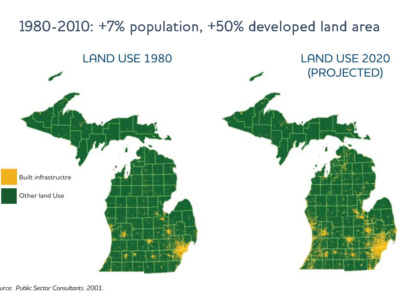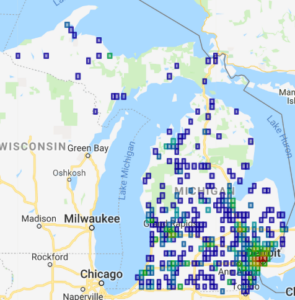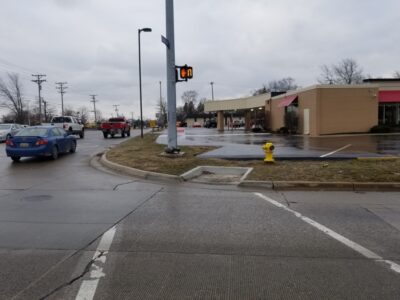Michigan’s roads took center stage (as if they ever leave it?) in this past November’s election, as now-Governor Gretchen Whitmer’s “Fix the damn roads,” slogan struck an obvious chord. While the need for pavement maintenance is obvious, it’s only one part of our state’s broken transportation system.
Beyond filling the potholes, Michigan is overdue for actual innovation that addresses our mobility needs holistically. Decades of experience have shown us that neither is a pavement-only approach fiscally sustainable, nor does it address our critical health, safety, and equity needs.
We know that we simply can’t afford to just double down on our road system.
In past years, we’ve built so many lane-miles, bridges, and interchanges that the state’s maintenance needs are now overwhelming even the hundreds of millions of dollars in general fund subsidy that we’re pumping into the roads each year.
As a new Senate Fiscal Agency analysis shows, even this diversion of funds away from other pressing needs is only enough to slow the decay. A functioning road network is essential to moving people and goods–but the decades of expanding our maintenance liabilities so much faster than our population or economy have grown has caught up to us with a vengeance.

While our population growth has been sluggish over past decades, we’ve spread out rapidly, taking on massive infrastructure maintenance costs (also known as “potholes”) in the process.
We know that roads alone are not sufficient for all of our residents’ mobility needs.
A third of Michigan residents cannot drive a car due to their age, a disability, or other factors; others are forced to drive uninsured because they cannot afford insurance and have no other options available.
The challenges in metro Detroit are well-documented, but are reflected around the state: Region 9’s Michigan Works! Agencies noted in 2015 that transportation was a barrier to finding and keeping a job for half of the customers they served, and lack of transportation is also the leading factor in missed medical appointments. With these challenges falling most heavily on people with disabilities, people of color, and low-income residents, a focus only on roads presents clear equity problems.
We know that our local, regional, and inter-city transit gaps are barriers to talent attraction.
In addition to lower-income workers’ job access, lack of transportation options limit Michigan’s high-skill, high-wage jobs as well. Amazon aside, consider Ann Arbor-based Duo Security, which recently became Michigan’s first-ever “unicorn” tech company when Cisco acquired it for $2.35B: founder Dug Song has previously cited a lack of transit options as one reason that the company opened satellite offices in other states.
There’s a ton of talent in Metro Detroit that we just don’t have access to because it’s too far for them to consider the commute…and that’s why we’re opening a California office. We’ve sped up out there because really, the talent is easier for us to pull from given the BART, given the CalTrain, than it is here.
You know, having to split up the company and do more in other places, I wish we could grow more here…We’re just very strong supporters of regional transit. I think it would be very helpful if we had trains that went to Detroit, the airport at least, to Grand Rapids, down to Columbus…Our challenge is we just need more access to talent.
And we know that a roads-first focus threatens public health and personal safety.
The state of Michigan and metro Detroit have the dubious honor of placing among the most dangerous regions in the country for pedestrians, with traffic crashes killing over 1,400 pedestrians in the past decade. In total, over 1,000 people have been dying in Michigan traffic crashes each year–another 75,000 are injured annually.

While only southeast Michigan made the national report, fatal pedestrian crashes touch every part of the state.
Outside of crashes, the impacts of air quality, stress, and simply sitting for long periods mean that an over-emphasis on cars and a lack of other options contributes to heart and respiratory diseases, reducing life expectancy.
Seniors, people of color, and low-income Michiganders are at greatest risk of being killed by drivers, and also tend to have the most exposure to hazardous air quality. Placing the greatest harms of our focus on roads on the groups of residents least benefiting from them adds injury to injury.
So let’s fix the roads–strategically, and for everyone.
We know that the roads do need work, of course. (After all, I drafted this while waiting for a dented rim and warped tire to be replaced…for the second time in as many years.)
What we need is to not pour money in the roads for the sake of action, but to ensure any transportation fixes are strategically and comprehensively improving Michigan’s health, economic opportunity, equity, and budget outlooks at the same time as we’re digging into our repaving backlog.
This means that at all levels–state, MPO, county, and local–we should,

Focusing too narrowly on the area between the curbs without thinking about the whole system can lead us into trouble.
- Place a moratorium on any new roads, lanes, bridges, or interchanges, including those previously authorized–and using any reconstruction project as opportunities for road diets that reduce, rather than increase, the amount of asphalt we’re on the hook to maintain in the future.
- Focus all business development incentives on locations already served by streets, and that offer transit, walking, or biking access to workforce: we can’t afford to “win” new business development in greenfield locations that add to our maintenance burden.
- Ensure that all work on our roads is looked at for opportunities to serve multiple transportation needs, not just pavement condition. A mill/overlay project may not trigger legal obligations for new curb ramps or crosswalks, but the marginal cost of adding those improvements to an existing project may bring substantial benefits to equity, accessibility, and quality of place.
- Use “tactical placemaking” to test-drive different options for our streets in advance of any construction project. Whether very temporary “pop-up” events or longer-term pilot projects, these let us experiment inexpensively before we commit plans to concrete. Where these pilots demonstrate that right-of-way can be rededicated from pavement to green infrastructure or pedestrian space, they can offer huge benefits over time, potentially even with reduced up-front costs. (And where they don’t, well, they didn’t cost much.)
- Invest appropriately in all parts of our transportation system. It may seem counter-intuitive to apply limited dollars to transit, or sidewalks, or bike infrastructure in the name of fixing the roads, but those investments can pay off by providing access to destinations in our communities more efficiently (and equitably) than spending all of our money on roads, while also contributing to the sense of place that makes our communities worth living in.
If we don’t do these things, but instead just try to pay our way to smooth pavement, then we will end up making a massive investment in “fixing” our roads that bakes in the current liabilities and inequities, guaranteeing ourselves even an even greater repair bill the next time. Let’s not make that mistake.
[/fusion_text][/fusion_builder_column][/fusion_builder_row][/fusion_builder_container]